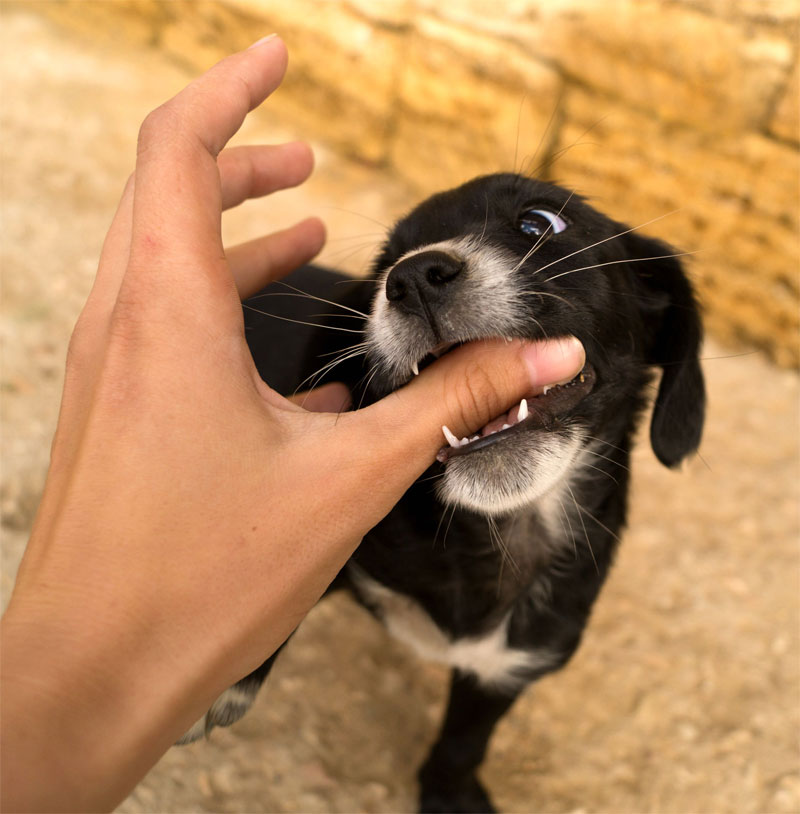
15 Aug Train Your Puppy Not To Bite
In order to most effectively eliminate the behaviour of biting in puppies, it is important to first understand why your puppy is biting you. Everyone knows just how sharp those needle like teeth can be, but why does your mostly cuddly affectionate friend bite you? I am often told by clients that their puppy is turning ‘aggressive’ or ‘dominant’ and this is just not the case! Biting (also referred to commonly as mouthing, nipping, snapping) is perfectly normal young dog behaviour, but can become painful and excessive if not dealt with appropriately.
Now bare with me, but we need to allow our puppies to bite us. Yes, let your puppy bite you! Puppies will start play biting their littermates as soon as they are able to- around 4 weeks of age. Other puppies in the litter will give feed back on the strength of this bite by yelping and stopping play if its too hard. This process teaches the puppy how hard they are biting and is called ‘bite inhibition’. When we take puppies from their littermates at 8-10 weeks of age, we are halting that all important process, and therefore need to continue teaching the dog how hard is ‘too hard’ ourselves. We have only until the dog reaches four and a half months of age to teach them this. After this point they are still teething and will want to chew but this need not be on people!
Why is this important?
Bite inhibition is in my opinion probably one of the most important things you will ever teach your dog. Whilst a puppy is young, its jaw strength is such that these bites cannot cause much damage. During this time the puppy will learn to control the force of its jaws appropriately as the muscle here develops. Feedback from humans and other dogs during this stage allows the dog to form bite inhibition or a soft mouth, whereby they are aware and in control of how they’re biting. This is so so important for adulthood, so when a dog snaps perhaps because he is frightened or surprised, the force applied is measured and less likely to hurt someone. For example, your dog is injured and reacts by biting when you try and move him to get to the vet. Here, a dog that has not been allowed to mouth and bite as a puppy will more than likely cause harm. A dog that has been taught bite inhibition will give a warning snap and rarely break the skin on a human.
If we take these same principles and apply them to dog on dog biting, the same is true again. Often you will see two dogs fighting and hear a lot of noise and commotion, however, upon examining the dogs after separation neither have any punctures. Here, most of the time no harm is done due to the finely tuned bite inhibition both animals have.
So, how do I tell my puppy it hurts?
According to Dr Ian Dunbar there are four stages of bite inhibition training, working first to decrease the force of the bites and then secondly to decrease the frequency.
- Teach the puppy not to bite hard. For most puppies this will involve making a sudden loud noise when they bite hard so as to shock them. As soon as they remove the pressure you reinforce them by resuming play.
- If this doesn’t work (the puppy is overwhelmed, over tired or thinks these noises are part of play) the puppy should be managed using an ex-pen. This is a small enclosed area, much bigger than the crate which can contain toys etc. When the puppy starts to bite particularly frantically remove him from the situation and allow him to decompress in this pen without human contact.
- When the puppy bites at hands or clothing stop moving- moving is misconstrued as play by puppies.
- When your puppy is chewing something desirable (a toy, bone etc) give praise and affection, help him to understand what is good and okay to chew on.
- Read Karen Pryors guide to clicker training your puppy how to gently use its mouth.
If after following these steps your puppy is still causing concern, do not hesitate to get in touch with a professional.


Sorry, the comment form is closed at this time.